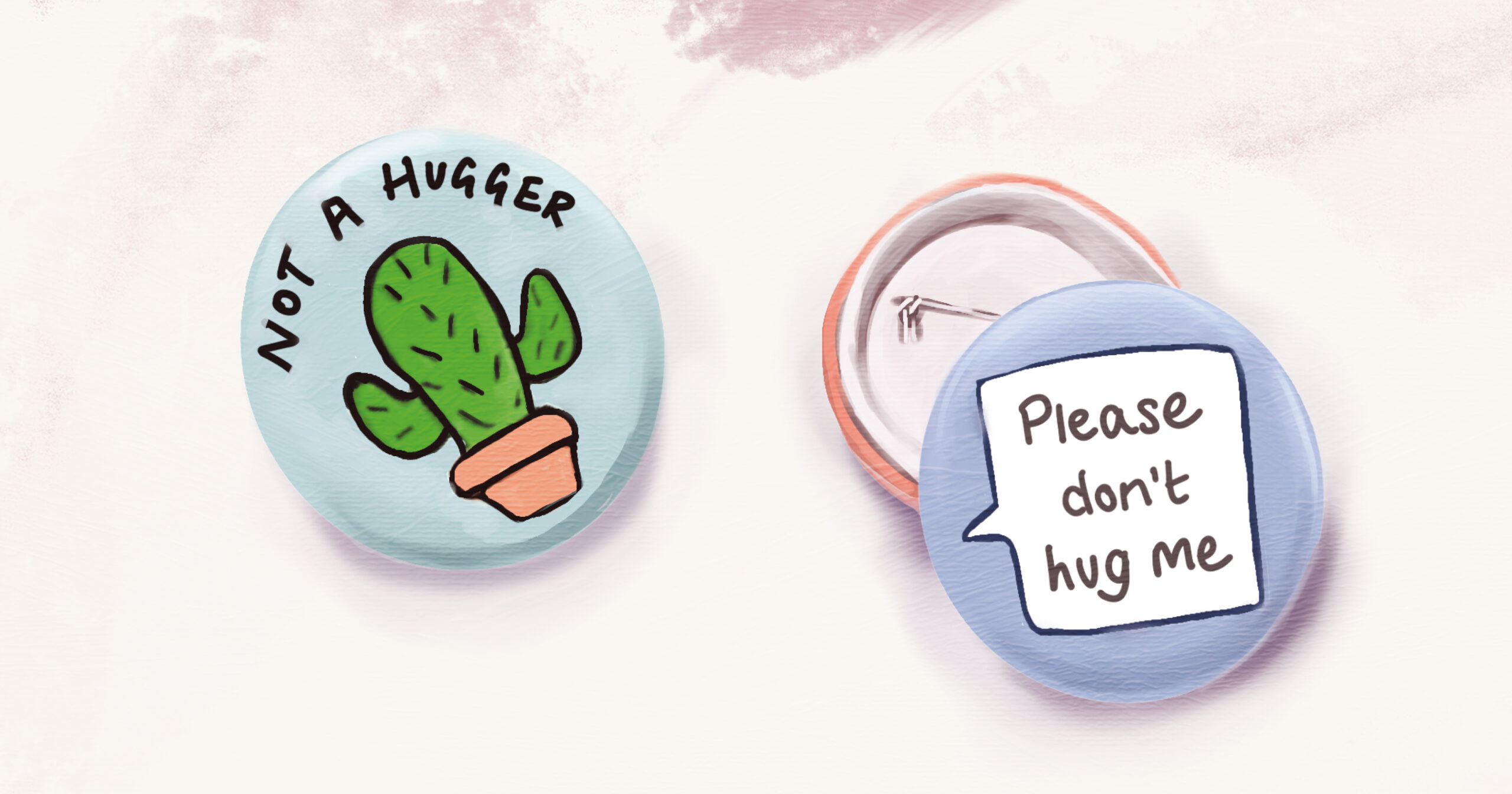Are you a hugger? For some people, hugging comes so naturally that they’re happy to throw their arms around complete strangers in a warm greeting or envelop their loved ones in a strong, lingering bear hug. Others might only feel comfortable hugging loved ones and dislike similar physical contact with colleagues or acquaintances. And there are those who regard casually entering their personal space for a hug as a complete no-no, as it makes them feel uncomfortable or even unsafe. Hugging etiquette can be a minefield, especially if you’re not sure whether the person you’re with is a hugger or not. Should you offer an embrace and, if so, how long should it last? Should you squeeze tightly, pat a shoulder or pull away quickly? And what do you do if you’re not a hugger and someone pulls you in? It’s tricky, but there are a few ways to navigate the situation.
Feel-good benefits
You might have heard the phrase ‘hugging it out’ to solve an interpersonal conflict or problem. Research suggests that reciprocal hugs often have numerous benefits, including building trust and a sense of safety, easing feelings of isolation or loneliness, boosting self-esteem, strengthening the immune system, lowering blood pressure and even improving heart health. Physical touch is thought to be so important that in some places there’s a trend for so-called cuddle cafés, where customers are encouraged to embrace strangers.
A hug can encourage the release of feel-good chemicals in the body, including the so-called love hormone oxytocin, mood-elevating serotonin and pleasure hormone dopamine. Anna Mathur is a UK-based psychotherapist, speaker and author, whose books include The Uncomfortable Truth and Know Your Worth. She says that, in the right circumstances, a hug can be wonderful. ‘I love a hug,’ she says. ‘Hugging is so good for the nervous system. It releases happy hormones like oxytocin and it’s good for connection. It’s especially good when you hug people who care about you and make you feel safe.’
Uncomfortable truth
For those who don’t enjoy an embrace, however, it can have the opposite effect. Anna says: ‘If you don’t enjoy hugging, then it doesn’t release oxytocin – it releases stress hormones instead, because you’re in a situation that you don’t feel comfortable with and doing something that’s conflicting with what you want to do.’ In other words, physical touch can only be of benefit if it’s between consenting people who feel relaxed and safe.
Sometimes, you might find yourself locked in an embrace out of a feeling of duty. Perhaps there are people you think you ought to hug, such as family members you don’t see often or friends of friends. Maybe a colleague is a hugger and you don’t want to go against the grain by proffering a hand for a handshake instead. Young people can feel particularly pressured when parents insist that they hug grandparents, aunts, uncles or family friends, even if they feel awkward. If you had this experience as a child, you might feel less inclined to be a hugger as an adult. Anna says: ‘People might not want to be hugged if they’ve had a negative experience or had it forced on them by a caregiver, or if they’ve experienced physical or emotional trauma. If you’ve had an unpleasant experience, you might want to hold that personal space to feel a bit safer.’
Neurodivergence is another reason why some people don’t enjoy hugs. A person who is autistic, for example, or has attention deficit hyperactivity disorder, could have sensory perceptions that make touch challenging. It’s also important to remember that different cultures have different boundaries for physical touch and hugs might not be in line with others’ belief systems.
There’s another aspect, too – one that’s perhaps less about the physical and more about the practical – hugging takes time. And some find it causes unnecessary delays, as well as making those who have to witness prolonged hugs feel uncomfortable, particularly if it looks awkward. As an example, in October 2024, Dunedin Airport, in New Zealand, set a three-minute time limit on hugs within its building, with signs telling travellers: ‘For fonder farewells, please use the car park.’ The airport explained that it wanted to make sure there was space for everyone in their drop-off areas.
Not for everyone
You don’t need a reason not to enjoy a hug or to be selective about who you want to embrace and when. Feeling uncomfortable is enough. Anna says: ‘It’s okay not to hug – you don’t have to do it. People just have different preferences.’ But expressing those preferences can be difficult if you live in a culture, environment, family or community where hugging is seen as ‘the norm’. Anna says: ‘It can leave people feeling quite “other” and confused, questioning why they feel like this or forcing themselves to feel okay with something they don’t really enjoy.’
If you don’t like hugging, holding that invisible boundary around yourself can help you feel comfortable and safe, but enforcing that boundary isn’t always easy. Anna suggests having what she calls ‘a party line’ – a simple phrase that tells everyone your position straight away. ‘If someone looks like they’re about to lean in for a hug, just hold your hand out and say: “I’m not a hugger, I’m a handshaker and it’s lovely to see you,”’ she says. Being upfront can help break any awkwardness and reassure the other person that it’s nothing personal against them.
‘It’s challenging the narrative that, if you don’t hug someone, they’ll think you’re being rude,’ says Anna. You could even buy an ‘I’m-not-a-hugger’ badge and pin it to your jacket. Anna adds that setting a boundary can also help to avoid the kind of tense embrace that makes everyone feel awkward. ‘Letting other people plough down your boundaries isn’t being kind and it’s not giving them the chance to respect what feels comfortable or uncomfortable to you,’ she says. You can also be proactive in thinking of other ways to greet people, say goodbye or show affection, such as offering to put the kettle on, giving them a warm smile or a compliment or having a special handshake.
What if I am a hugger?
Even if you love hugs, it’s unrealistic to assume that everyone else will love hugging you, and sometimes there’s nothing worse than an unwanted embrace. ‘If you love hugs, as many people do, you can go about it in a way that respects other people’s boundaries,’ says Anna. ‘Think about consent and pull away if you feel tension.’ It’s about being aware of other people’s body language. How do they look as you walk towards them? Are they moving towards you or leaning in as they say ‘hello’ or ‘goodbye’? You can watch how they behave with other people in the group, too. If they move around a room shaking hands with everyone else, it’s likely they might behave like that towards you, too. If in doubt, you can always simply smile and ask: ‘Are you a hugger?’
Occasionally, even with the best intentions, people misread each other and well-intentioned hugs end up feeling uncomfortable. Says Anna: ‘If you notice resistance, tension or awkwardness, make a note and think: “Okay, next time I see them I’m just going to give them an extra big mega-watt smile instead.”’ And you can always look forward to seeing those people who give mutually enjoyable bear hugs.
Anna concludes: ‘Remember, if someone finds it hard or feels uncomfortable being hugged, no matter how normalised it is, that’s still their personal preference and it’s not about you.’ Walking towards someone with open arms isn’t always going to be reciprocated, but don’t take it personally. Everyone has their own preferences and boundaries, and with a little respect, it’s possible to meet and greet each other in a way that leaves us all feeling comfortable.
Hugging Etiquette
A few pointers to help navigate the issue
Check before you go in
When you move towards another person, notice their body language. Are they leaning towards you and opening their arms or holding themselves away?
Feel it out
As you embrace, observe how the other person responds. Are they holding you tightly or does their body feel tense? Be aware of where your hands are and don’t be overly intimate.
Prepare to break away
Move out of the contact as soon as you feel the other person loosening their grip. Don’t cling to them or try to prolong the embrace.
Be clear about your own boundaries
If you don’t want to hug, say so from the outset, before any physical touch happens. Be concise, clear and polite, so no one feels offended or snubbed.
Don’t take it personally
Sometimes a hug, or lack of one, can end up feeling uncomfortable. Smile and move on. Don’t get hung up about it or it’ll make the rest of the encounter awkward, too.
Offer an alternative
If a hug isn’t wanted, give the other person a big smile and think of other ways to show that you’re happy to be in their company.
For more about Anna’s work, visit annamathur.com or follow @annamathur on Instagram


